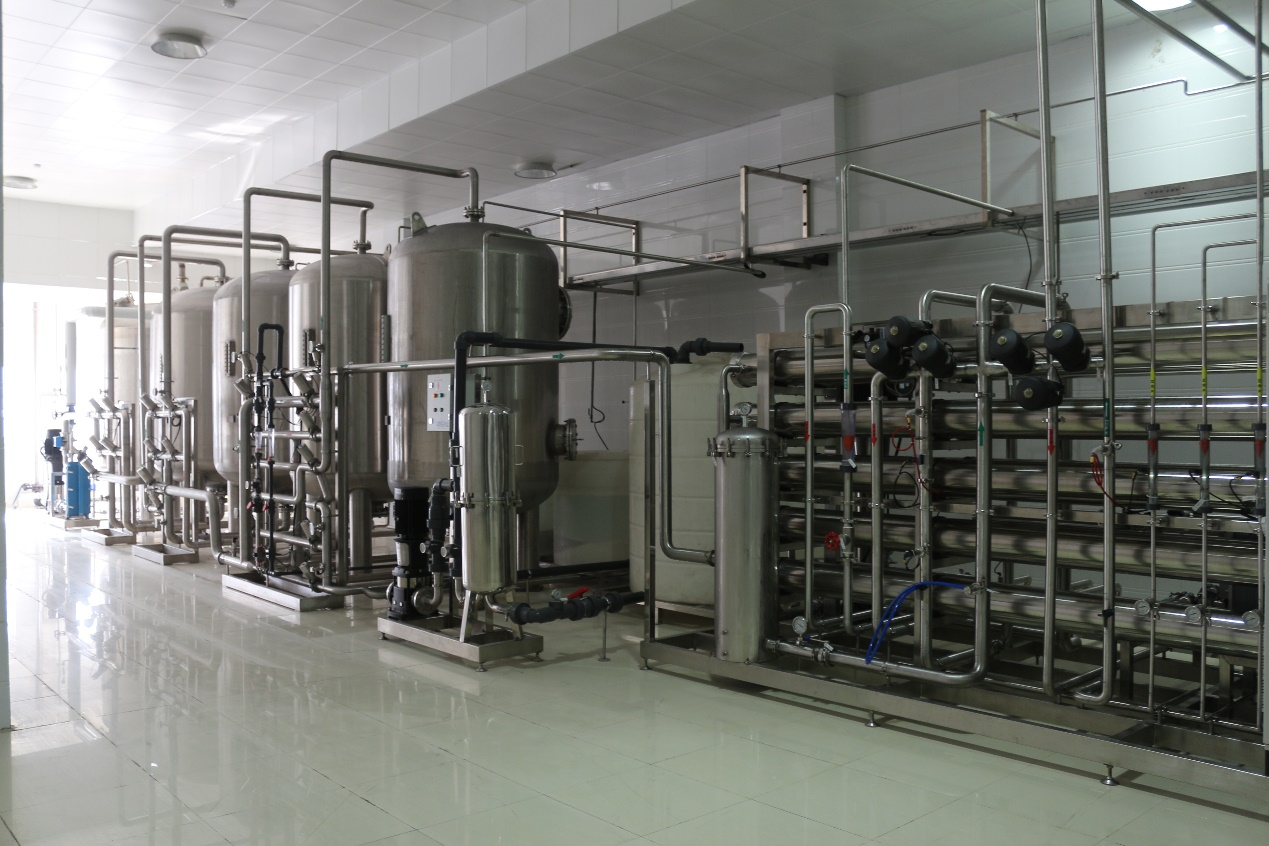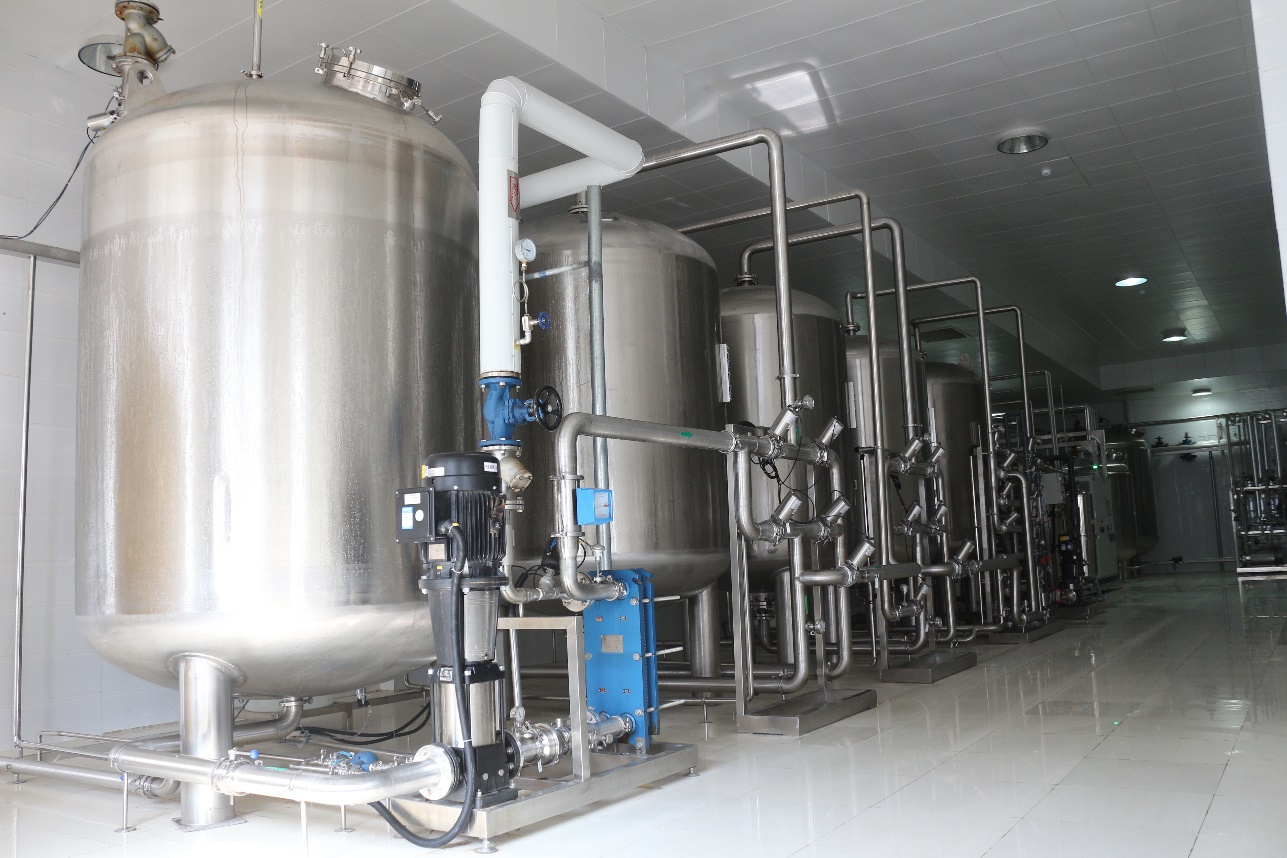Our company designs the system based on the raw water quality and production water quality requirements provided by the companies under Sichuan Taiji Group. The system configuration and settings can fully meet the requirements under the water inlet conditions, with the principles of automatic, energy-saving, simple operation, environmental protection and safety, and ensure that the system can operate stably for a long time. According to the raw water (inlet) water quality parameters and outlet water requirements provided by the demander, our company's design department adopted a 15m 3 / h two-stage reverse osmosis purified water system. The following process is adopted: raw water tank → raw water pump → multi-media filter → activated carbon filter (pasteurization) → softener (one standby and one use) → 5μm precision filter → high pressure pump 1 → (dosing device) reverse osmosis unit 1 (cleaning system) → high pressure pump 2 (dosing device) → reverse osmosis unit 2 (cleaning system) → purified water storage tank → water point. The system adopts fully automatic human-machine interface control and monitoring to ensure the normal operation of the reverse osmosis system, and is also equipped with a series of online test instruments, including conductivity meter, flow meter, pressure gauge, etc. All instrument joint blind pipes in contact with product water are in compliance with 3D requirements to ensure no secondary pollution of purified water quality, thus ensuring long-term stable operation of the system. In this project system:
(1) The pretreatment system uses multi-media filters and activated carbon filters. Their operation, exit, water backwash, air scrubbing, and commissioning are all automatically controlled. The exit operation mechanism is controlled by the set operation time. The disinfection and sterilization of the quartz sand filter and the activated carbon filter are automatically completed through the operation of the control system.
(2) Due to the quality of the influent water, a softener device is also equipped in the pretreatment system. The cation exchanger passes the raw water through the sodium cation exchange resin, so that the hardness components Ca2+ and Mg2+ in the water are exchanged with the Na+ in the resin, thereby absorbing the Ca2+ and Mg2+ in the water and softening the water. This prevents the salts formed by the concentration of Ca2+ and Mg2+ ions by reverse osmosis from scaling on the surface of the reverse osmosis membrane, which ultimately affects the performance of the reverse osmosis membrane.
(3) Pasteurization is composed of control components such as heaters, circulation pumps, valves, and thermometers. The outlet water temperature is controlled above 80°C (80~85°C) through the heater, and circulated for 1-2 hours to kill most pathogens. The heat exchange system is fully automatic, and the disinfection temperature and time can be set by yourself, as well as the records and storage of the disinfection temperature and time. This heat exchange system uses a double tube sheet shell and tube heat exchanger made of 316l. The design can avoid cross contamination of the two media (industrial steam and pure water), which meets the domestic GMP and FDA certification requirements.
(4) The reverse osmosis membrane group is the core part of the whole desalination system. It is mainly responsible for removing soluble salts, colloids, organic matter and microorganisms in water. It can remove more than 97% of ions in water. According to water quality analysis, the reverse osmosis membrane assembly adopts the world's advanced imported aromatic polyamide composite membrane. The normal output of the system is 15T/h, and the reverse osmosis recovery rate is 70%. According to software calculation, the reverse osmosis membrane group adopts a 3:2 arrangement. The first section adopts a pressure vessel with 3 3-meter-long 8" membrane elements, and the second section adopts a pressure vessel with 2 3-meter-long 8" membrane elements. The reverse osmosis system can also effectively remove TOC and endotoxins, and the TOC removal rate reaches 90%. The concentrated water discharge valve is set on the reverse osmosis water production side, which can discharge the concentrated water generated in a short time when the machine is just started, shut down for maintenance, and debugging, and prevent it from entering the later process. The reverse osmosis system is adopted because it has a very high desalination capacity. In order to ensure the safety and flexibility of the system operation, the reverse osmosis system is configured in a single row. The reverse osmosis system 2 includes three parts: a high-pressure pump, a reverse osmosis membrane group and a control instrument. It is also equipped with an online PH adjustment system, the purpose of which is to adjust the PH value of water, thereby reducing the conductivity of the product water. Since the removal rate of CO2 by the reverse osmosis membrane is zero, and the presence of CO2 in the product water makes the product water contain HCO3- and CO32-, the conductivity of the product water is relatively high. Since the reverse osmosis membrane has a high desalination rate for HCO3- and CO32-, the PH adjustment device increases the PH value of the raw water, reduces the concentration of CO2 in the water, and converts it into HCO3- and CO32-, thereby reducing the CO2 component in the product water, thereby reducing the conductivity of the outlet water.
(5) In addition, the system is equipped with a terminal pure water tank to ensure that the purified water produced by the reverse osmosis system enters the pure water tank, and then is delivered to each water point through the purified water delivery pump to ensure the stability and continuity of water supply to each water point. In order to meet the verification requirements, the pure water tank is equipped with an air respirator to prevent the water level from rising and falling, and the dust and microorganisms in the air brought in and out by the air, to ensure that the purified water is not polluted and to prevent the box from deformation. The pure water tank is equipped with a cleaning spray head to automatically clean the water tank. It is also equipped with a liquid level sensor, which is controlled by the plc and can display the liquid level of the water tank on the touch screen. The liquid level of the pure water tank is interlocked with the high-pressure pump 2. When the liquid level of the pure water tank is higher than the set value, the high-pressure pump 2 stops operating. In order to achieve full automatic control of the entire system.
The entire system is equipped with a central electrical control cabinet. All control and detection instruments, as well as electrical switches and electrical components are concentrated in the control cabinet. The control box is equipped with a Siemens plc programmable controller and a Siemens LCD touch screen. Realize full automatic operation control and monitoring during the pure water preparation process. The working process and status of the equipment can be displayed on the touch screen, and the temperature, conductivity, flow rate and other parameters during the operation can be displayed on the screen. The touch screen is equipped with relevant selection switch screens, which can realize the automatic and manual switching of the system or equipment. This ensures the operation stability of the entire set of equipment. According to the feedback from customers after actual operation, the purpose and requirements designed by customers at that time have been achieved.


 ch
ch English
English




